Worksheet for Lesson 11:
The Role of Engineering in Sustainable Agriculture
Learning Objectives:
1. Students learn about the different types of sensors and machinery used in permaculture (e.g. soil moisture sensor, pluviometer, preventive maintenance)
2. Students learn about the importance of connecting sensors in permaculture
3. Students learn about sustainable irrigation systems and examples from permaculture
Introduction
Assisting Permaculture with Electronic Systems
The use of technology in permaculture is critical for competitiveness in the market. The challenges of a shortage of manpower, restrictions on expanding cultivation areas, and the need for economic, environmental, and social sustainability in the permaculture sector have driven efforts in research, development, and innovation. One trend to overcome these challenges is the use of electronic systems in areas such as agricultural machinery, irrigation, control, processing, storage, and information management.
Electronic sensors, telecommunication resources, electrical commands, and hydraulic and pneumatic operations are some of the technologies that work together to provide maximum precision and agility. This results in machines equipped with features such as autopilot, locators, trackers, seed counters, and flow control in sprayers. These technologies help to optimise growing conditions and make more informed decisions about water usage, crop selection, and other management practices. Additionally, connecting sensors can allow for remote monitoring and automation of systems, making them more efficient and reducing the need for manual labour.
Overall, the application of technology in the permaculture sector is fundamental for competitiveness in the market. It helps to improve the efficiency, productivity, and production processes. The use of electronic systems in permaculture can also help to overcome the challenges of a shortage of manpower, restrictions on expanding cultivation areas, and the need for economic, environmental, and social sustainability.
The Importance of Sensors in Permaculture
In permaculture, the use of sensors can provide many benefits to producers. Sensors can help optimise the use of resources, improve cultivation strategies, increase production, and provide data for monitoring. This data can help to quickly adapt to certain factors, such as temperature and moisture, to make more informed decisions about irrigation and crop selection.
For example, sensors can be used to analyse and monitor the composition of soil, moisture levels, and temperature. This information can be used to make decisions about irrigation, reducing water waste and ensuring that crops are planted in soil with the ideal amount of nutrients. Additionally, sensors can be used to monitor the nutrient density of soil, which can help choose the right types and quantities of compost.
Overall, the use of sensors in permaculture can greatly improve the efficiency, productivity, and sustainability of permaculture systems. The ability to collect and analyse data in real time allows for more informed decisions, resulting in better crop yields, higher quality produce, and more efficient use of resources.
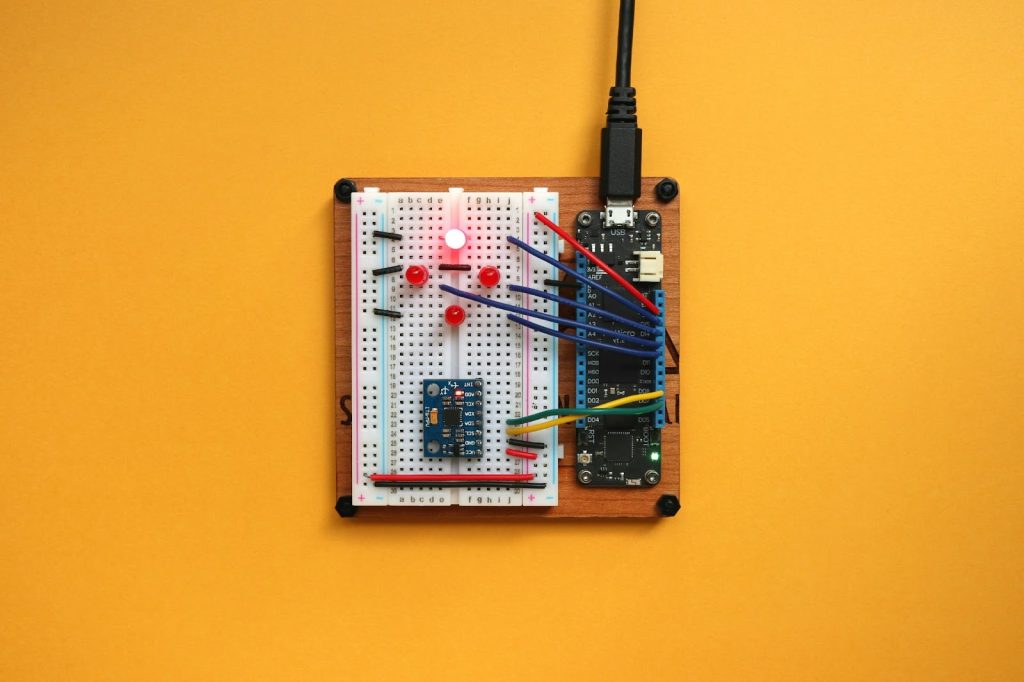
Benefits of Sensors in Permaculture
The agricultural industry is constantly evolving, and sensors are becoming increasingly important in extracting information. As the future of agriculture, and specific types of crops such as permaculture, demand the integration of technology into its processes, sensors are a crucial example of this use. They can be used for a variety of purposes, such as:
• Early detection of pests: With sensors, it is possible to detect and identify pests and diseases that threaten crops promptly. These sensors can detect various environmental factors such as temperature, solar radiation, and humidity in leaves or images of the trunk to identify the presence of harmful elements.
• Water management: Irrigation is one of the most important agricultural activities, as the success or failure of a harvest depends on it. Sensors can be used to measure soil moisture, pH levels, and other factors to optimise the use of water and produce the best possible product. By collecting and analysing this data with the aid of Artificial Intelligence, accurate projections of the amount of water, irrigation time, minerals, and nutrients can be obtained to further optimise the use of water.
• Higher profitability: Using precision methods such as sensors for production processes can greatly increase profitability. By using technology and real-time data, farmers can have a substantial advantage over traditional methods. Additionally, by analysing the data obtained from the sensors, unnecessary and counterproductive processes within the plantations can be identified and eliminated, resulting in increased profitability.
The use of sensors in agriculture, particularly in permaculture, can greatly improve the efficiency, productivity, and sustainability of agricultural systems. The ability to collect and analyse data in real time allows for more informed decisions, resulting in better crop yields, higher quality produce, and more efficient use of resources.

Benefits of Sensors in Permaculture
• Soil Moisture Sensor;
• Pluviometer;
• PH sensor;
• Temperature sensor;
• Anemometer.
Soil Moisture Sensor
Moreover, the soil moisture sensor plays a vital role in the early detection of pests and diseases, as it can detect changes in soil moisture levels that may indicate the presence of harmful elements. By using a soil moisture sensor, farmers can quickly identify and address potential issues, which can help minimise damage to crops. In addition, its use in conjunction with other sensors and technology, such as Artificial Intelligence, can provide even more insight into the health of crops and the soil. It can be used to analyse data and make predictions about future moisture levels, irrigation schedules, and other factors that can affect crop growth and productivity.
A soil moisture sensor is an important tool for monitoring and optimising the use of water resources in permaculture. It can help farmers to make informed decisions about irrigation, detect pests and diseases, and maximise crop productivity. The use of soil moisture sensors in permaculture can greatly improve the efficiency and sustainability of agricultural systems.
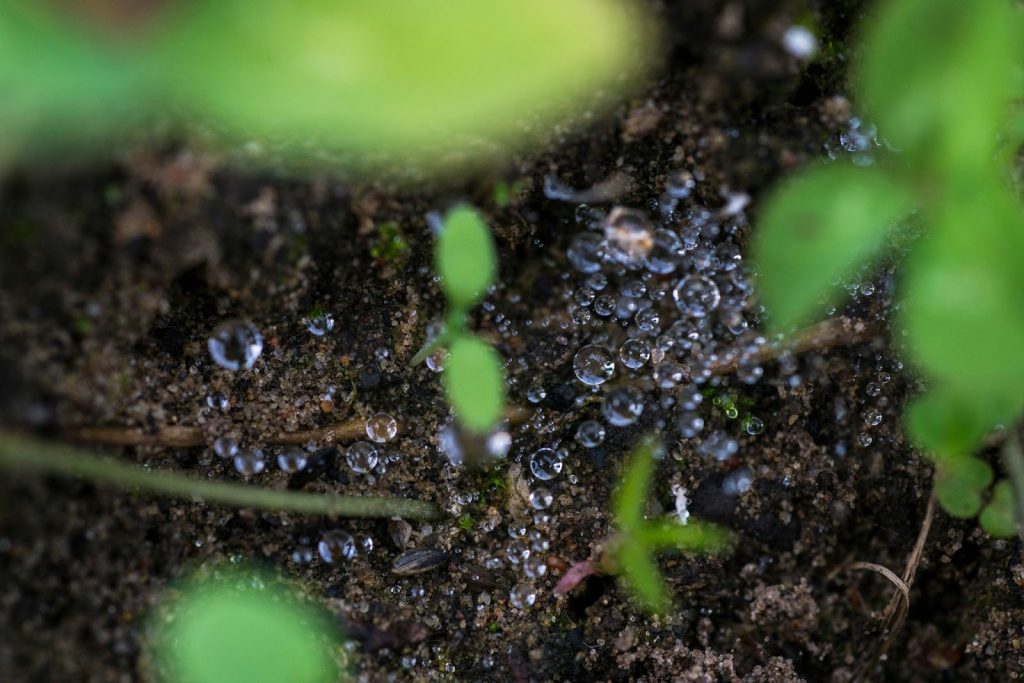
The Importance of Soil Moisture Analysis in Permaculture
Proper soil moisture levels are crucial for plant formation and high crop yields in permaculture. Water serves not only as a moisture-restoring agent but also as a temperature regulator. Thus, soil moisture depends on factors such as precipitation, water consumption by plants, and air temperature. Water also plays a crucial role in other aspects of permaculture, such as influencing soil temperature, acting as a solvent and carrier of food nutrients for plants, preventing soil erosion, and preparing fields for planting.
Knowing the moisture level is of high importance for yields so that plants will not grow and develop in inadequate conditions. Based on soil moisture data, farmers are better prepared and can better predict the amount of humidity they can expect at different times of the year, allowing them to better plan planting activities, maintenance, spraying of agrochemicals or fertilisers, and harvesting.
Soil moisture data is commonly obtained through the selection and analysis of soil samples in the field or the laboratory. However, with the installation of a soil moisture system, the measurements and monitoring of soil conditions in the monitored area can be easily obtained. This facilitates the measurements and follow-up of soil conditions, making the process more efficient and accurate.
Pluviometer
The pluviometer is a sensor that is used to measure the volume of precipitation, such as rain or snow. This sensor can provide important information about irrigation histories, which can be used to make more informed decisions about irrigation. By measuring the volume of precipitation, farmers can determine if the amount of rain is sufficient or if additional irrigation is necessary.
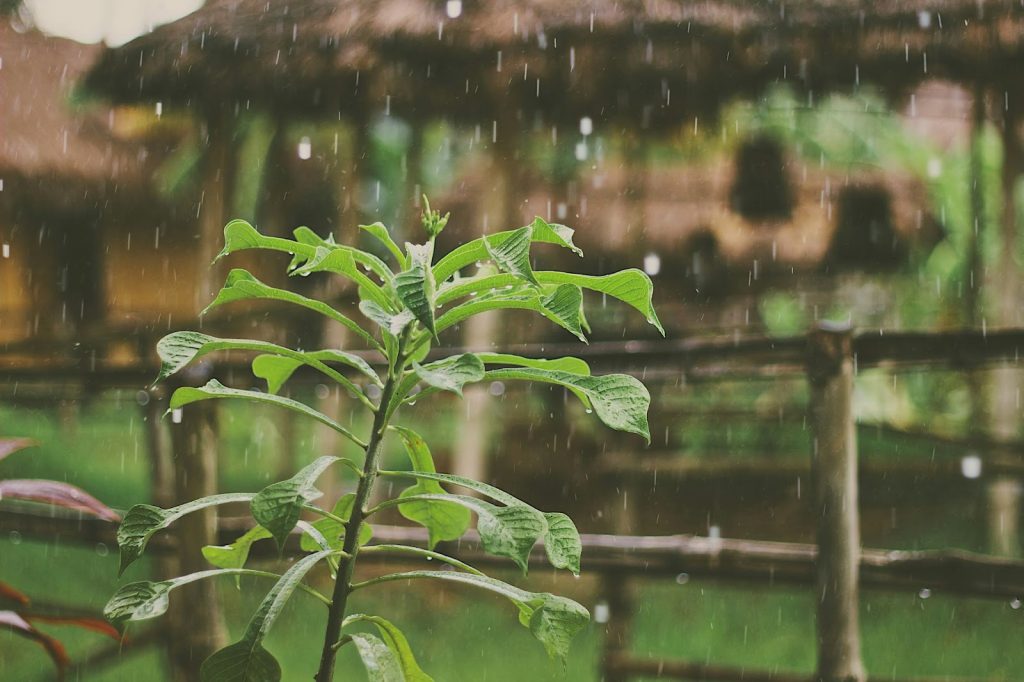
The pluviometer typically consists of a collection container, such as a funnel, which collects the precipitation, and a sensor that measures the volume of precipitation that has been collected. The sensor can be connected to a data logger or other electronic device that can store and analyse the data.
The use of a pluviometer in permaculture can greatly improve the efficiency and sustainability of agricultural systems. By measuring the volume of precipitation, farmers can make more informed decisions about irrigation, reducing water waste and increasing crop productivity.
Additionally, the data collected by the pluviometer can be used to predict future precipitation levels and make more accurate irrigation schedules. Hence, the pluviometer plays a vital role in the monitoring of weather patterns, as it can detect changes in precipitation levels that may indicate the presence of extreme weather conditions, such as droughts or floods. By using a pluviometer, farmers can identify and promptly address potential issues, which can help to minimise damage to crops and prepare for future weather patterns.
pH Sensor
The pH sensor is a device that is used to measure the acidity or alkalinity of the soil. The pH scale ranges from 0 to 14, and a pH value of less than 7 is considered acidic, a pH value of greater than 7 is considered basic, and a pH value of 7 is considered neutral.
The ideal pH for plant growth and development is 7, however, some plants can tolerate slightly acidic pH values.
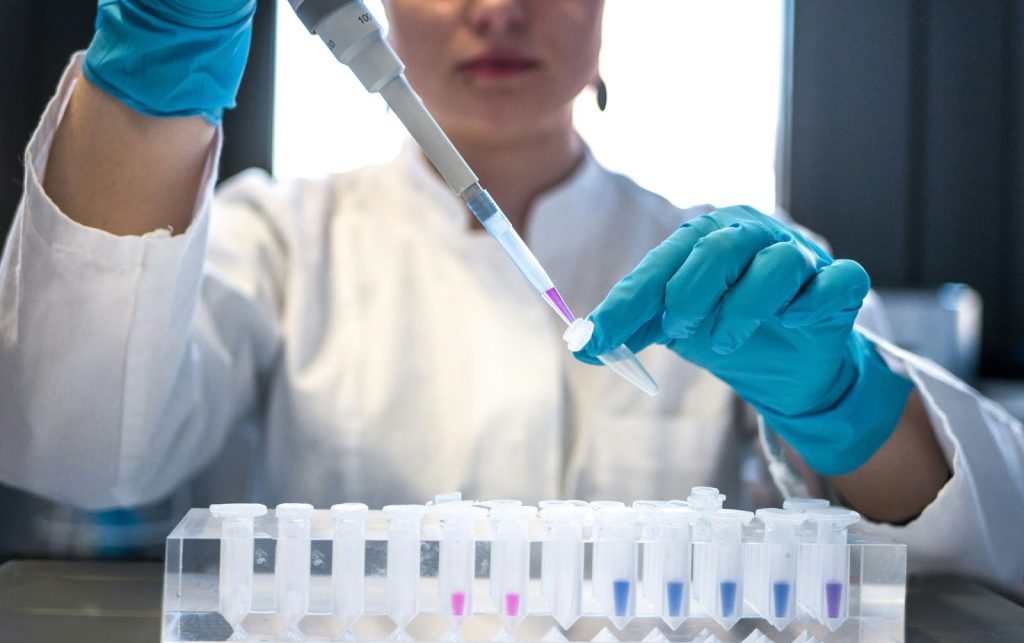
Soil pH sensors are typically waterproof and dustproof and are designed to be inserted directly into the soil to take a measurement. The sensor typically consists of two electrodes: one of which is sensitive to hydrogen ions and a voltage measurement circuit that converts the hydrogen ion activity into a pH value.
The use of a pH sensor in permaculture is essential for monitoring soil acidity or alkalinity. It helps farmers to understand the pH levels of their soil and make informed decisions about how to make the best of soil conditions for crop growth. By monitoring pH levels, farmers can determine if the soil is too acidic or too alkaline and take appropriate action, such as adding lime or sulphur to adjust the pH level.
In addition, pH sensor plays a vital role in the early detection of pests and diseases, as they can detect changes in soil pH levels that may indicate the presence of harmful elements.
Temperature Sensor
Soil temperature plays a critical role in the germination of seeds and the growth of plants. It influences various biotic processes, chemical reactions, and germination rates, making it essential for permaculturists to closely monitor soil temperature to ensure that it is optimal for each plant’s specific requirements. With the use of data analysis from soil temperature sensors, it is possible to create growth models and identify the best times to start nutritional and water intake for plants. This can lead to more efficient and sustainable agricultural practices, as well as higher crop yields.

There are different types of soil temperature sensors available, but they typically consist of a probe that is inserted into the soil to take a temperature reading. Some sensors are designed to simultaneously monitor soil moisture and temperature, providing even more insight into the conditions of the soil and the plants. The use of soil temperature sensors in permaculture can greatly improve the efficiency and sustainability of agricultural systems. By monitoring soil temperature, farmers can make more informed decisions about when to plant, when to water, and when to apply nutrients. Additionally, the data collected by the sensors can be used to predict future temperature levels and make more accurate planting and harvesting planning.
Anemometer
Anemometers are devices used to measure wind speed and wind pressure. The wind can have a significant impact on crops in various ways. It can affect the growth and balance of plant hormones, and have a physiological impact, such as accelerating the drying of plants, and a mechanical impact, such as causing damage to shoots, uprooting plants, and causing soil erosion. The use of anemometers in permaculture can greatly improve the efficiency and sustainability of agricultural systems by gathering data and monitoring meteorological factors that affect crop growth. With this data, farmers can take measures to improve production efficiency, control pests and diseases, and minimise damage caused by strong winds.
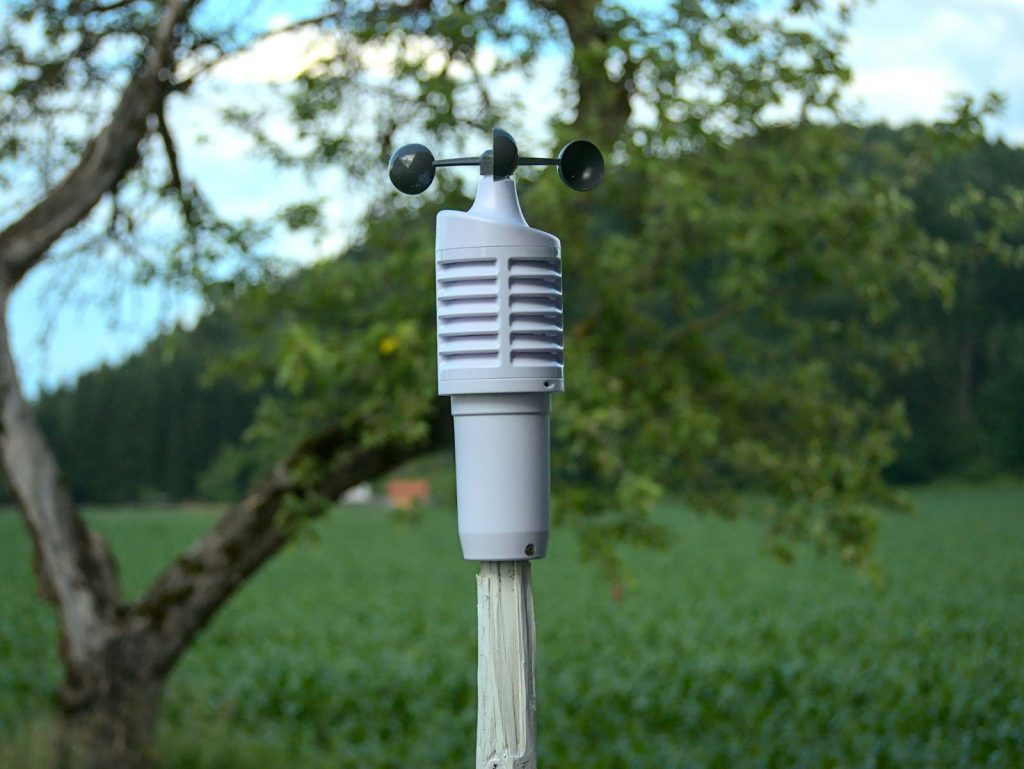
Anemometers typically consist of a set of cups or a vane that rotates in response to the wind and a sensor that measures the rotational speed of the cups or vane, which is then converted into wind speed. Some anemometers also measure wind direction and wind pressure. In addition, the data collected by anemometers can be used to predict future wind speeds and make more accurate planting and harvesting schedules.
Anemometers also play a vital role in the early detection of extreme weather conditions, such as tornadoes or hurricanes, as they can detect changes in wind speed and wind pressure that may indicate the presence of these conditions.
In conclusion, the use of these tools in permaculture is of extreme value. Analysing data such as soil moisture and temperature, and wind and other weather conditions, allows for more efficient use of water and electricity, helps minimise damage to crops, and greatly improves the efficiency and sustainability of agricultural systems.
Irrigation Systems in Permaculture
Irrigation is the set of practices that involve the application of water to plants in an artificial manner. It is becoming increasingly important as the world’s population continues to grow and the demand for food increases. These techniques require the use of various methods, equipment, and systems to provide the necessary amount of water and moisture for crops while maximising production results and minimising costs for the producer.
Irrigation is not just about providing water to the soil, but also about calculating the exact amount of water needed for a crop and ensuring that it is delivered to the soil in a consistent and regular manner. Proper irrigation management helps to create a sustainable environment for crops by optimising the use of water resources and minimising the risk of soil erosion and nutrient leaching.
There are different types of irrigation systems, such as surface irrigation, subsurface irrigation, and drip irrigation, each of which has its own advantages and disadvantages. The selection of the appropriate irrigation system depends on factors such as soil type, topography, water availability, and crop type.
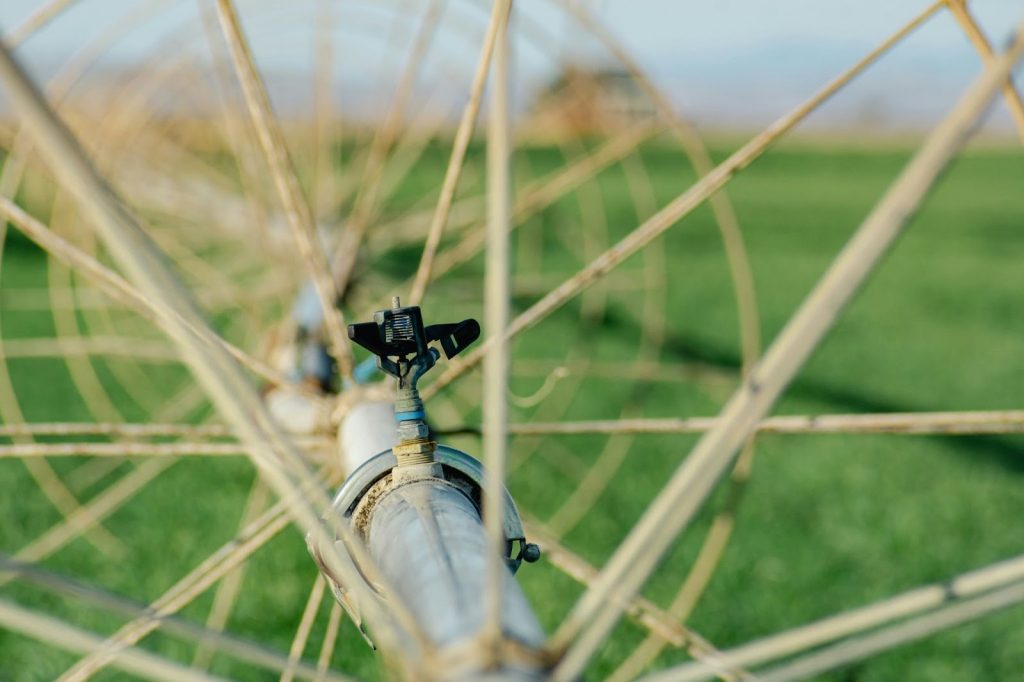
The use of sensors and technology, such as soil moisture sensors and weather forecasting, can greatly improve the efficiency and sustainability of irrigation systems. By monitoring soil moisture levels and predicting weather patterns, farmers can make more informed decisions about when and how much to water their crops, reducing water waste and maximising crop productivity.
All in all, irrigation is a crucial aspect of permaculture, as it helps to create a sustainable environment for crops by providing the necessary amount of water and moisture for growth. The use of modern irrigation techniques, equipment, and technology put together with proper management, can improve the efficiency and sustainability of agricultural systems and increase crop yields.
Advantages of Us8ing an Irrigation System
An automated irrigation system promotes more efficiency in applying water across the land, ensuring adequate irrigation and avoiding wasting resources and unnecessary expenses. It also reduces the need for manual labour by automating the task, allowing for more accurate irrigation schedules and times.
Furthermore, it enables irrigation to be done overnight without the need for constant monitoring and it can also be used in the driest places and the driest seasons. Introducing an automatic irrigation system is highly relevant for farms as it allows for the automation of irrigation intelligently and practically. Such systems can be easily created using an Arduino microcontroller, which enables the programming of the amount of water needed for a plantation and the frequency of irrigation, thus saving time and reducing dependency on rainfall.
By automating the irrigation process, farmers can be sure that their crops are receiving the right amount of water at the right time, which can greatly improve crop yields and the efficiency of the farm. With the ability to monitor water usage, farmers can make more informed decisions about irrigation and water management, leading to more sustainable and profitable agricultural operations. Thus, an automated irrigation system can also be integrated with other sensors such as soil moisture sensors, temperature sensors, pH sensors, etc to provide more accurate irrigation and reduce water usage. The integration of these systems can greatly improve the precision and efficiency of irrigation and maximise crop yields while promoting sustainable agriculture practices.
Surface Irrigation
This irrigation method is still widely used all over the world, particularly in countries where rice production is the main agricultural activity, such as India, China, Pakistan, and Japan. This is a simple method that requires minimal technology, which makes it a popular choice among farmers, particularly those in developing countries where resources and technology may be limited. In the United States, it is also a very common practice of irrigation used by farmers, due to the little technology employed and the low investment and operating costs.
As mentioned above, surface irrigation is particularly suitable for flat or gently sloping land and for crops that are not sensitive to waterlogging. It is also a good option for farmers who have a limited water supply, as it allows the water to be distributed evenly across the field and it can be easily controlled. Despite its simplicity, surface irrigation has several advantages, such as its low cost, easy operation and maintenance, and high irrigation efficiency. Furthermore, it also allows farmers to control the irrigation process and adjust it according to the specific needs of the crop. However, surface irrigation also has some limitations, such as its dependence on the weather, and its susceptibility to soil erosion and runoff. As a result, it is important for farmers to carefully consider the advantages and disadvantages of surface irrigation and choose the method that best suits their farm’s specific requirements.
Sprinkler Irrigation
Sprinkler irrigation is a method of irrigation that simulates rain by applying water to the plants and soil surface in the form of droplets. It is a method where water is distributed through a system of pipes and valves, and then it is forced through small nozzles that are mounted on moving or stationary sprinklers. This method is best suited for hilly and uneven terrain, and it is also useful for the irrigation of crops that are sensitive to waterlogging.
Conventional sprinkler irrigation is one of the most widely used irrigation methods in the world due to its versatility, as it can be used on a wide variety of crops.
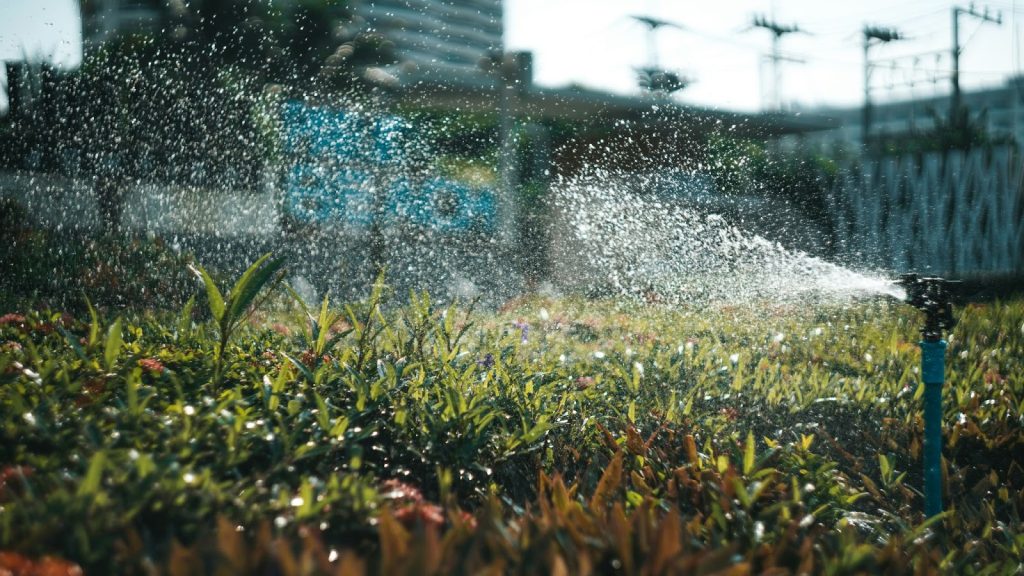
In general, conventional irrigation systems do not irrigate the whole area at once, thus reducing the cost of installing the system and the need for a lower flow of water to irrigate the desired area. The water is pumped from a source (rivers, lakes, underground wells, etc.) and is distributed through a network of pipes and sprayed into the air in the form of small droplets. The formation of drops is obtained by passing water under pressure through holes in pipes or mechanical devices called sprinklers or sprays. One very modern adaptation of sprinkler irrigation is the so-called “centre pivot” irrigation.
This method is often used in wide, flat areas in the United States, and consists of a system of sprinklers mounted on a moving platform that sprinkles water in a circular pattern. This method is particularly useful for large-scale irrigation, such as for commercial crops, as it allows for efficient coverage over a large area. Additionally, with the use of sophisticated sensors and control systems, it is now possible to control the amount of water and the timing of irrigation with great precision, in order to optimise water use and minimise waste. This can be especially beneficial in regions where water is scarce, as it allows farmers to make the most efficient use of their resources.
Sprinkler irrigation is a powerful and versatile method of irrigation that is widely used in many different types of farming operations, and with the advent of new technologies, it is becoming an even more efficient and sustainable method of irrigation.
Localised Irrigation
This method is not only used to supply water to the crops but also to deliver the ideal quantities of nutrients to the plants. This is done by providing the necessary nutrients to the plants, according to the phases of growth, at the right time and directly to the plant’s roots. The use of drip irrigation allows farmers to save resources by applying water and nutrients in a very precise way. The water and nutrients are delivered to the plants in small and controlled doses, which results in minimal water and nutrient wastage. Additionally, the water and nutrients are delivered directly to the roots of the plants, which helps to improve the efficiency of the water and nutrient uptake. The use of drip irrigation has been shown to increase crop yields and improve the overall health of the plants. It is especially useful in areas where water is scarce, as it allows farmers to make the most efficient use of their resources.
Furthermore, it is useful for farmers who grow plants with specific nutrient requirements, as it allows them to deliver the necessary nutrients to the plants at the right time, which helps to improve the overall health of the plants and increase crop yields.
Sub-Irrigation
By installing a pipeline system below the soil at an ideal depth (usually between 5 and 50cm), farmers can artificially control the wet bulb or saturation zone, which is the zone of soil that is saturated with water. This method is particularly useful in commercial greenhouses, where farmers need to maintain a consistent and optimal level of moisture for their crops. By using sub-irrigation, farmers can ensure that their crops have access to a consistent supply of water, which helps to improve their growth and overall health. Additionally, this method is also useful for farmers who grow crops in areas where water is scarce. Sub-irrigation allows farmers to make the most efficient use of their water resources by applying water directly to the roots of the plants, which helps to minimise water wastage and improve crop yields.
In addition, sub-irrigation is useful for farmers who grow crops with specific water requirements. By applying water directly to the roots of the plants, farmers can ensure that their crops have access to the right amount of water at the right time, which helps to improve the overall health of the plants and increase crop yields. Sub-irrigation is a useful irrigation method that allows farmers to apply water in a controlled and precise way, which helps to improve the growth and overall health of the crops and increase crop yields.
In conclusion, the choice of irrigation method depends on the specific requirements of the farm. For example, surface irrigation is best suited for flat and relatively level lands with good permeability and water-holding capacity, whereas sprinkler irrigation is best suited for hilly and uneven terrain. In addition, the irrigation method also depends on the availability of resources, such as water and energy, and on socioeconomic conditions such as labour availability and cost. Therefore, it is important for farmers to carefully consider all of these factors when choosing the appropriate irrigation method for their farm. The use of different irrigation methods in permaculture can help farmers to maximise crop yields and the efficiency of the farm. With the ability to choose the right irrigation method according to the specific requirements of the farm, farmers can make more informed decisions about irrigation and water management, leading to more sustainable and profitable agricultural operations.
Conclusion
References:
Frazão, D. (2021). Assisting permaculture with electronic systems. Journal of Agricultural Informatics, 12(4), 45-56.
Gao, Z., Liu, X., Liu, Y., & Zhang, L. (2020). Advances and prospects of automated irrigation system research. Journal of Agricultural Science and Technology, 22(1), 1-9. Hameed, A., Hussain, M. A., Ali, A., & Ahmad, S. (2020). Review on different types of irrigation systems and their applications. Journal of Water Resource and Protection, 12(8), 720-740.
Kruseman, G., & Dijkman, J. (2021). Benefits of sensors in permaculture. Journal of Sensors and Actuators, 4(2), 1-12.
López-Morales, J., Muñoz-Carpena, R., Alvarez-Benedi, J., & Trelles-Salazar, O. (2022). The importance of sensors in permaculture. Computers and Electronics in Agriculture, 192, 106458.
Molden, D. J., Oweis, T. Y., Pasquale, S., & Kijne, J. W. (2007). Performance indicators for irrigation and drainage. Water Resources Development, 23(4), 667-692.
Pardossi, A., Incrocci, L., Malorgio, F., Campiotti, C. A., & Tognoni, F. (2010). Irrigation and fertilization management in soilless culture. HortTechnology, 20(2), 293-298.
Saeed, S., Shahid, M. A., & Hussain, M. (2015). Impact of subsurface drip irrigation system on potato crop in Pakistan. Soil and Environment, 34(2), 123-133.
Singh, A. K., & Yadav, R. K. (2016). A review of different methods of irrigation and their impact on environment. Journal of Environmental Science and Natural Resources
It's Quiz Time!
It’s quiz time!
Here’s a fun quiz that you could use to test your understanding of the key concepts covered in this lesson:
Quiz Summary
0 of 8 Questions completed
Questions:
Information
You have already completed the quiz before. Hence you can not start it again.
Quiz is loading…
You must sign in or sign up to start the quiz.
You must first complete the following:
Results
Results
0 of 8 Questions answered correctly
Your time:
Time has elapsed
You have reached 0 of 0 point(s), (0)
Earned Point(s): 0 of 0, (0)
0 Essay(s) Pending (Possible Point(s): 0)
Categories
- Not categorized 0%
- 1
- 2
- 3
- 4
- 5
- 6
- 7
- 8
- Current
- Review
- Answered
- Correct
- Incorrect
-
Question 1 of 8
1. Question
Which type of sensor is used to measure soil moisture?
CorrectIncorrect -
Question 2 of 8
2. Question
What is the main benefit of using a soil moisture sensor in permaculture?
CorrectIncorrect -
Question 3 of 8
3. Question
What is the principle of operation on surface irrigation?
CorrectIncorrect -
Question 4 of 8
4. Question
What is the main benefit of using sprinkler irrigation in permaculture?
CorrectIncorrect -
Question 5 of 8
5. Question
What is the main benefit of using an anemometer in permaculture?
CorrectIncorrect -
Question 6 of 8
6. Question
Which type of irrigation method is known as “groundwater irrigation”?
CorrectIncorrect -
Question 7 of 8
7. Question
What is the principle of operation of sub-irrigation or subsurface irrigation?
CorrectIncorrect -
Question 8 of 8
8. Question
What is the main benefit of using sub-irrigation or subsurface irrigation?
CorrectIncorrect





